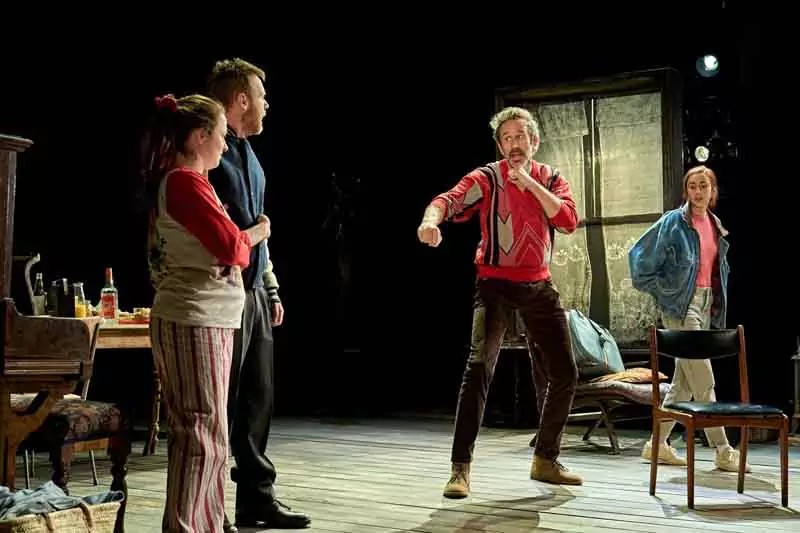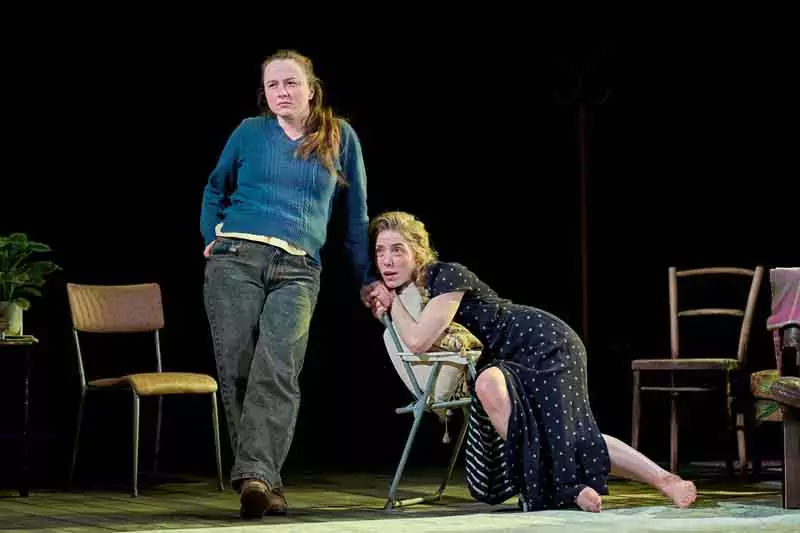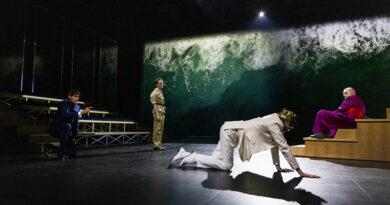“The Brightening Air” at the Old Vic
Jeremy Malies in the West End
26 April 2025
Rosie Sheehy pecks out a few diminished chords on an upright piano and I ask myself if we will be in the same territory as Conor McPherson’s wonderful Girl from the North Country at the same venue. But McPherson (who also directs) sets his new play on the Irish coast near Sligo. We’ve come a long way from Dylan’s Minnesota.

Photo credit: Manuel Harlan.
It’s in no way derivative but this is in part Brian Friel territory, not just the geographical location but the dysfunctional family, unrequited loves, and Irish spin on Chekhovian melancholy as well as stoicism at the end. There is a shock over a will, a bogus love potion, and a miraculous restoration of sight to a shyster defrocked clergyman who has spoken about the Vatican. “The Church needs you now, father!” got a huge topical laugh. Is this in the script and fortuitous or an ad lib? I don’t know.
The setting is the early 1980s though this comes as drip-feed in minor details such as the pub being about to have a Pac-Man machine installed. It is in no way a period piece (the tone is often quite folkloric) and the play will have a long shelf life.
Sheehy plays Billie, a mildly autistic travel obsessive who can give you forensic details of possible rail journeys as far as Istanbul and the Ganges where (if you fear reincarnation) you should have your ashes scattered to avoid coming back in another iteration. This theme is repeated at the end to give the three-act play a circular structure. Billie’s neurodivergence in terms of social communication, sensory processing, and list-making is presented with great sensitivity and even meditation amid the humour.
There is a keening quality to the way that Billie bemoans the hand she has been dealt. I was struck by a wonderful moment as the other characters who care about her form a circle and say they wish she could be … nobody quite has the bluntness to say “normal” and the audience of course is thinking in a new lexicon that includes “neurotypical”.

Rosie Sheehy and Hannah Morrish.
Photo credit: Manuel Harlan.
Nobody is happy here, and there is another stunning performance from Hannah Morrish as the desperate Lydia. She can’t rid herself of an infatuation with worthless estranged husband Dermot played by Chris O’Dowd. I’ve seldom seen physical longing expressed so graphically and so inventively without any crudity. Sheehy and Morrish have prodigious techniques. And O’Dowd is the first actor I’ve seen whose charisma and vitality might sustain him credibly as the lead in Jez Butterworth’s Jerusalem should it get a deserved post-Mark Rylance revival.
Conscious fraud Father Pierre (Seán McGinley) recovers from feigned blindness, and turns the cottage with its considerable land into a Satan-worshipping residential sanctuary. He didn’t want to see things but when he can defraud his brother’s children of an inheritance, he is suddenly empowered. McPherson gives Pierre a fine speech in which he moves away from antitheism to a Mephistophelean figure. Costume designer Rae Smith fits McGinley out skilfully in the high-end resort hotel clothes of an American tele-evangelist.
Lighting by Mark Henderson is full of painterly ideas without being intrusive. As Billie’s brother Stephen (played by Brian Gleeson) paces around the huge kitchen it as though he is moving through the light and dark of a painting. Stephen has a good (non-cringey) but abortive sex scene with Elizabeth (Derbhle Crotty) who has been working as a paid companion to Father Pierre. Even without the sex having happened, she tells Stephen that he smells of “alone-ness”.
Alder trees suggesting decorations on Chinese pottery are at the rear of the set which is also by Rae Smith. (Morrish moves through it as though this is shadow puppetry.) Smith has bizarre crepe shapes adorn a curtain at the beginning of the final act which I could not fathom. The forest backdrop stuck in my mind and Henderson’s lighting brought it out in delicate ceramic relief.
There is a pre-recorded video interlude between acts two and three which I didn’t understand. It may show people from the area that McPherson has in mind who have inspired the characters. The subjects looked so attuned to the locale, and the Eighties Kodak soft film palette (video supervisor Alex Ramsden) is pulled off so well that I just enjoyed the video in and of itself.
Any criticisms? Occasionally there is a lurch and you think, “Here comes this character’s big, beautiful and lyrical set-piece speech!” The monologues don’t always spring logically from the preceding dialogue, and I just wonder if McPherson should have directed this himself though he is assisted by Anastasia Osei-Kuffour. He has a long history of directing his own work. Unaccountably, the script makes no attempt to show how the family acquired and expanded a substantial (if crumbling) property that will sustain a residential religious commune at the end. And Pierre’s lump inheritance comes from a codicil to his brother’s will. You would think that the younger generation might have protested.
There is no music that might have been popular in the Eighties jukebox in the pub up the road. Instead, Billie and Stephen pick out Ravel’s early-twentieth-century “Pavane for a Dead Princess” which certainly has no relevance in terms of the plot.
The title of the play comes from a Yeats poem about … unrequited love. Yeats wrote a few plays, was a founder of the Abbey Theatre in Dublin, a practical man of the theatre, and known for his ruthless judgements of scripts. I shouldn’t ventriloquize him, but I reckon he would give this new play an enthusiastic thumbs-up.








